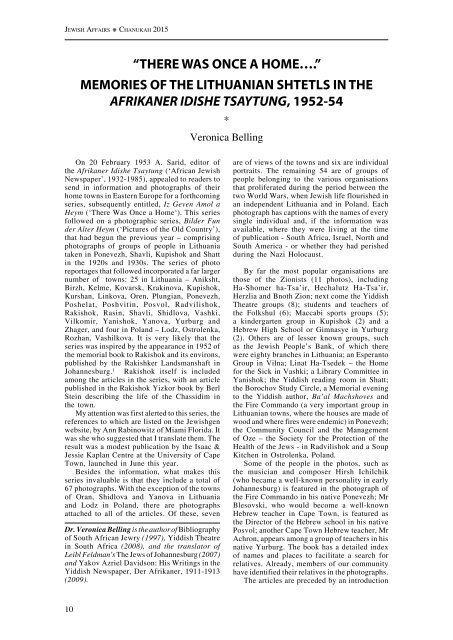J A
Jewish-Affairs-Chanukah-2015
Jewish-Affairs-Chanukah-2015
You also want an ePaper? Increase the reach of your titles
YUMPU automatically turns print PDFs into web optimized ePapers that Google loves.
JEWISH AFFAIRS Chanukah 2015<br />
On 20 February 1953 A. Sarid, editor of<br />
the Afrikaner Idishe Tsaytung (‘African Jewish<br />
Newspaper’, 1932-1985), appealed to readers to<br />
send in information and photographs of their<br />
home towns in Eastern Europe for a forthcoming<br />
series, subsequently entitled, Iz Geven Amol a<br />
Heym (‘There Was Once a Home‘). This series<br />
followed on a photographic series, Bilder Fun<br />
der Alter Heym (‘Pictures of the Old Country’),<br />
that had begun the previous year – comprising<br />
photographs of groups of people in Lithuania<br />
taken in Ponevezh, Shavli, Kupishok and Shatt<br />
in the 1920s and 1930s. The series of photo<br />
reportages that followed incorporated a far larger<br />
number of towns: 25 in Lithuania – Aniksht,<br />
Birzh, Kelme, Kovarsk, Krakinova, Kupishok,<br />
Kurshan, Linkova, Oren, Plungian, Ponevezh,<br />
Poshelat, Poshvitin, Posvol, Radvilishok,<br />
Rakishok, Rasin, Shavli, Shidlova, Vashki,<br />
Vilkomir, Yanishok, Yanova, Yurburg and<br />
Zhager, and four in Poland – Lodz, Ostrolenka,<br />
Rozhan, Vashilkova. It is very likely that the<br />
series was inspired by the appearance in 1952 of<br />
the memorial book to Rakishok and its environs,<br />
published by the Rakishker Landsmanshaft in<br />
Johannesburg. 1 Rakishok itself is included<br />
among the articles in the series, with an article<br />
published in the Rakishok Yizkor book by Berl<br />
Stein describing the life of the Chassidim in<br />
the town.<br />
My attention was first alerted to this series, the<br />
references to which are listed on the Jewishgen<br />
website, by Ann Rabinowitz of Miami Florida. It<br />
was she who suggested that I translate them. The<br />
result was a modest publication by the Isaac &<br />
Jessie Kaplan Centre at the University of Cape<br />
Town, launched in June this year.<br />
Besides the information, what makes this<br />
series invaluable is that they include a total of<br />
67 photographs. With the exception of the towns<br />
of Oran, Shidlova and Yanova in Lithuania<br />
and Lodz in Poland, there are photographs<br />
attached to all of the articles. Of these, seven<br />
Dr. Veronica Belling is the author of Bibliography<br />
of South African Jewry (1997), Yiddish Theatre<br />
in South Africa (2008), and the translator of<br />
Leibl Feldman's The Jews of Johannesburg (2007)<br />
and Yakov Azriel Davidson: His Writings in the<br />
Yiddish Newspaper, Der Afrikaner, 1911-1913<br />
(2009).<br />
are of views of the towns and six are individual<br />
portraits. The remaining 54 are of groups of<br />
people belonging to the various organisations<br />
that proliferated during the period between the<br />
two World Wars, when Jewish life flourished in<br />
an independent Lithuania and in Poland. Each<br />
photograph has captions with the names of every<br />
single individual and, if the information was<br />
available, where they were living at the time<br />
of publication - South Africa, Israel, North and<br />
South America - or whether they had perished<br />
during the Nazi Holocaust.<br />
By far the most popular organisations are<br />
those of the Zionists (11 photos), including<br />
Ha-Shomer ha-Tsa’ir, Hechalutz Ha-Tsa’ir,<br />
Herzlia and Bnoth Zion; next come the Yiddish<br />
Theatre groups (8); students and teachers of<br />
the Folkshul (6); Maccabi sports groups (5);<br />
a kindergarten group in Kupishok (2) and a<br />
Hebrew High School or Gimnasye in Yurburg<br />
(2). Others are of lesser known groups, such<br />
as the Jewish People’s Bank, of which there<br />
were eighty branches in Lithuania; an Esperanto<br />
Group in Vilna; Linat Ha-Tsedek – the Home<br />
for the Sick in Vashki; a Library Committee in<br />
Yanishok; the Yiddish reading room in Shatt;<br />
the Borochov Study Circle, a Memorial evening<br />
to the Yiddish author, Ba’al Machshoves and<br />
the Fire Commando (a very important group in<br />
Lithuanian towns, where the houses are made of<br />
wood and where fires were endemic) in Ponevezh;<br />
the Community Council and the Management<br />
of Oze – the Society for the Protection of the<br />
Health of the Jews - in Radvilishok and a Soup<br />
Kitchen in Ostrolenka, Poland.<br />
Some of the people in the photos, such as<br />
the musician and composer Hirsh Ichilchik<br />
(who became a well-known personality in early<br />
Johannesburg) is featured in the photograph of<br />
the Fire Commando in his native Ponevezh; Mr<br />
Blesovski, who would become a well-known<br />
Hebrew teacher in Cape Town, is featured as<br />
the Director of the Hebrew school in his native<br />
Posvol; another Cape Town Hebrew teacher, Mr<br />
Achron, appears among a group of teachers in his<br />
native Yurburg. The book has a detailed index<br />
of names and places to facilitate a search for<br />
relatives. Already, members of our community<br />
have identified their relatives in the photographs.<br />
The articles are preceded by an introduction<br />
10


